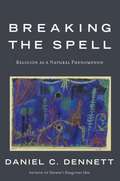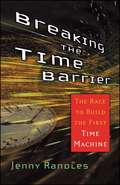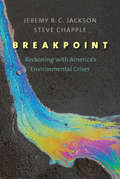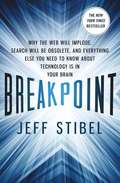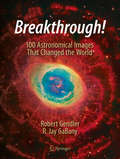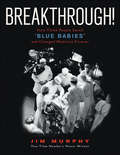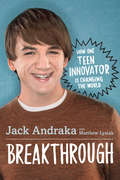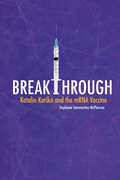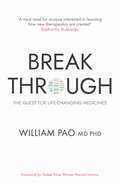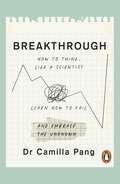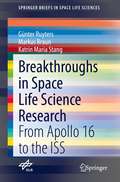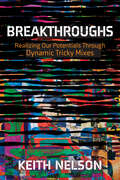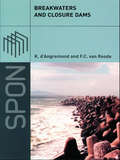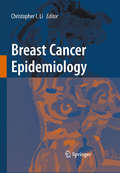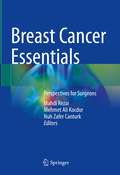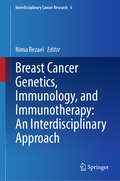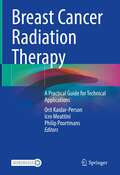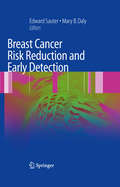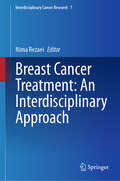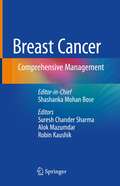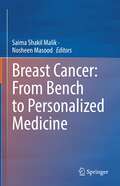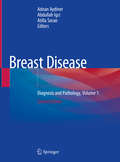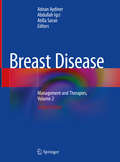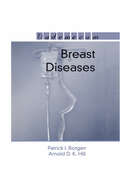- Table View
- List View
Breaking the Spell: Religion as a Natural Phenomenon
by Daniel C. DennettFor all the thousands of books that have been written about religion, few until this one have attempted to examine it scientifically: to ask why-and how-it has shaped so many lives so strongly. Is religion a product of blind evolutionary instinct or rational choice? Is it truly the best way to live a moral life? Ranging through biology, history, and psychology, Daniel C. Dennett charts religion's evolution from "wild" folk belief to "domesticated" dogma. Not an antireligious screed but an unblinking look beneath the veil of orthodoxy, Breaking the Spell will be read and debated by believers and skeptics alike.
Breaking the Time Barrier: The Race to Build the First Time Machine
by Jenny RandlesIT WAS ONLY A MATTER OF TIME.... Once widely considered an impossibility--the stuff of science fiction novels--time travel may finally be achieved in the twenty-first century. In Breaking the Time Barrier, bestselling author Jenny Randles reveals the nature of recent, breakthrough experiments that are turning this fantasy into reality. The race to build the first time machine is a fascinating saga that began about a century ago, when scientists such as Marconi and Edison and Einstein carried out research aimed at producing a working time machine. Today, physicists are conducting remarkable experiments that involve slowing the passage of information, freezing light, and breaking the speed of light--and thus the time barrier. In the 1960s we had the "space race." Today, there is a "time race" involving an underground community of working scientists who are increasingly convinced that a time machine of some sort is finally possible. Here, Randles explores the often riveting motives of the people involved in this quest (including a host of sincere, if sometimes misguided amateurs), the consequences for society should time travel become a part of everyday life, and what evidence might indicate that it has already become reality. For, if time travel is going to happen--and some Russian scientists already claim to have achieved it in a lab--then its effects may already be apparent.
Breakpoint: Reckoning with America's Environmental Crises
by Jeremy B. Jackson Steve ChappleAn insightful look at the American environmental crisis and emerging solutions from the heartland to the coasts in the era of global climate change†‹ Eminent ecologist Jeremy B. C. Jackson and award†‘winning journalist Steve Chapple traveled the length of the Mississippi River interviewing farmers, fishermen, scientists, and policymakers to better understand the mounting environmental problems ravaging the United States. Along their journey, which quickly expands to California, Florida, and New York, the pair uncovered surprising and profound connections between ecological systems and environmental crises across the country. Artfully weaving together independent research and engaging storytelling, Jackson and Chapple examine the looming threats from recent hurricanes and fires, industrial agriculture, river mismanagement, extreme weather events, drought, and rising sea levels that are pushing the country toward the breaking point of ecological and economic collapse. Yet, despite these challenges, the authors provide optimistic and practical solutions for addressing these multidimensional issues to achieve greater environmental stability, human well†‘being, and future economic prosperity. With a passionate call to action, they look hopefully toward emerging and achievable solutions to preserve the country’s future.
Breakpoint: Why The Web Will Implode, Search Will Be Obsolete, and Everything Else You Need To Know About Technology Is In Your Brain
by Jeff StibelWhat can the human brain and its relationship to the internet tell us about our society, our technologies, and our businesses? A lot, as it turns out. The internet today is a virtual replica of the brain, and the networks that leverage it grow and collapse in ways that are easily predictable if you understand the brain and other biological networks. We're living in the midst of a networking revolution. All of the major technology innovations of the 21st century - social networking, cloud computing, search engines, and crowdsourcing, to name a few - leverage the internet and are thus bound by the rules of networks. We've seen the exponential growth of these technologies, and they've led to a more efficient and tightly connected world. But what many people don't realize is that all networks eventually reach a breakpoint and collapse. This happens in the brain, it happens in nature, it happened to MySpace, and it will happen to Facebook and Google. It is critical to understand where the breakpoint is in the networks you use in order to achieve optimum success. Navigating the world of new technologies today can be like walking through a minefield unless you know the path. Imagine what you could do with a roadmap for where things are headed? In this fascinating look at the future of business and technology, neuroscientist and entrepreneur Jeff Stibel shows how the brain can act as a guide to understanding the future of the internet and the constellation of businesses and technologies that run on it. He'll show how leaders like Marissa Mayer are using artificial intelligence to literally remake Yahoo! and how startups like oDesk and Kickstarter are using crowdsourcing, the next wave of revolutionary technology, to create something much larger and "smarter" than the sum of their parts. Stibel offers a fresh perspective about the future of business and technology in a candid and engaging manner.
Breakthrough!: 100 Astronomical Images That Changed the World
by Robert Gendler R. Jay GabanyThis unique volume by two renowned astrophotographers unveils the science and history behind 100 of the most significant astronomical images of all time. The authors have carefully selected their list of images from across time and technology to bring to the reader the most relevant photographic images spanning all eras of modern astronomical history. Based on scientific evidence today we have a basic notion of how Earth and the universe came to be. The road to this knowledge was paved with 175 years of astronomical images acquired by the coupling of two revolutionary technologies - the camera and telescope. With ingenuity and determination humankind would quickly embrace these technologies to tell the story of the cosmos and unravel its mysteries. This book presents in pictures and words a photographic chronology of our aspiration to understand the universe. From the first fledgling attempts to photograph the Moon, planets, and stars to the marvels of orbiting observatories that record the cosmos at energies beyond the range of human vision, astronomers have always relied on images to "break through" to the next level of understanding. A subset of these breakthrough images has profound significance in documenting some of the greatest milestones in modern astronomy.
Breakthrough!: How Three People Saved "Blue Babies" and Changed Medicine Forever
by Jim MurphyIn 1944 a groundbreaking operation repaired the congenital heart defect known as blue baby syndrome. The operation's success brought the surgeon Alfred Blalock international fame and paved the way for open-heart surgery. But the technique had been painstakingly developed by Vivien Thomas, Blalock's African American lab assistant, who stood behind Blalock in the operating room to give him step-by-step instructions. The stories of this medical and social breakthrough and the lives of Thomas, Blalock, and their colleague Dr. Helen Taussig are intertwined in this compelling nonfiction narrative.
Breakthrough: How One Teen Innovator Is Changing the World
by Matthew Lysiak Jack AndrakaFor the first time, teen innovator and scientist Jack Andraka tells the story behind his revolutionary discovery. When a dear family friend passed away from pancreatic cancer, Jack was inspired to create a better method of early detection. At the age of fifteen, he garnered international attention for his breakthrough: a four-cent strip of paper capable of detecting pancreatic, ovarian, and lung cancers four hundred times more effectively than the previous standard.Jack's story is not just a story of dizzying international success; it is a story of overcoming depression and homophobic bullying and finding the resilience to persevere and come out. His account inspires young people, who he argues are the most innovative, to fight for the right to be taken seriously and to pursue our own dreams. Do-it-yourself science experiments are included in each chapter, making Breakthrough perfect for STEM curriculum. But above all, Jack's memoir empowers his generation with the knowledge that we can each change the world if we only have the courage to try.
Breakthrough: Katalin Karikó and the mRNA Vaccine
by Stephanie Sammartino McPhersonA thorough and accessible biography of Dr. Katalin Karikó, winner of the 2023 Nobel Prize in Physiology or Medicine, whose hard work pioneering mRNA research led to the COVID-19 vaccines. Her monumental contribution to global health care has rightfully placed Karikó as one of the most important scientists in history. She has won awards, given speeches, and appeared in magazines and television programs. But she wasn’t always famous—in fact, it took decades for anyone to recognize the importance of her research into RNA and the potential of mRNA to help cells fight off disease. Beginning with her birth in a small village in rural Hungary, Breakthrough tells the story of how a young girl interested in the wildlife around her became an internationally celebrated hero. Exuberant, devoted to her family, and hard-working, Karikó persevered in the face of challenges and obstacles that would have discouraged many of her peers. Her achievements remind us that if we believe in ourselves, no matter the setbacks we encounter, we can succeed.
Breakthrough: The Quest for Life-Changing Medicines
by Dr William PaoMeet the doctors, scientists, patients and campaigners tackling the world&’s worst diseases We often hear about the dark side of the pharmaceutical industry – from extortionate pricing to the opioid epidemic. But there&’s another story to be told. Through the story of eight revolutionary treatments, Dr William Pao cuts to the innovative heart of medical science and celebrates the tireless work of those fighting for better care. Behind each of these medicines – whether a potentially life-saving new treatment for cancer, or something as commonplace as paracetamol – there stands a cast of characters and a wealth of stories. The trajectory from the laboratory to the local chemist is rarely a straight line. Eureka moments are few are far between. Drug hunting demands leaps of imagination and lateral thinking, the accumulation of the knowledge and expertise of many, and – nearly always – a hefty dollop of luck. Breakthrough documents these journeys and grants a privileged look at the stories behind the medicines that improve – and very often save – our lives.
Breakthrough: What can we learn about the world and ourselves if we think like scientists?
by Camilla PangFROM THE AWARD-WINNING AUTHOR OF EXPLAINING HUMANS'A wondrous hymn to the scientific method, and some of its most profound discoveries, and what it can teach us all about how to live better and richer lives' Prof. Lewis Dartnell, author of BEING HUMAN: How our Biology shaped World HistoryA scientist’s journey from observation to discovery is anything but straightforward.It is littered with failure, unexpected diversions and joyous realizations. Science helps us to understand ourselves – but what we know about the world around us, what has already been explored and discovered, is only half of science’s story.Dr Camilla Pang will look at some of the biggest mysteries facing science today and how some of the best, most cutting-edge scientists can illuminate our own approaches to observation, hypothesis, exploration, troubleshooting and discovery in our own lives.
Breakthroughs in Space Life Science Research: From Apollo 16 to the ISS (SpringerBriefs in Space Life Sciences)
by Markus Braun Günter Ruyters Katrin Maria StangThis last volume of the SpringerBriefs in Space Life Sciences series is setup in 5 main parts. The 1st part shortly summarizes the history of life science research in space from the late 40s until today with focus on Europe and Germany, followed by a part on describing flight opportunities including the Space Shuttle/Spacelab system and the International Space Station ISS; in the 3rd part it focuses on extraordinary success stories of this constantly challenging research program and highlights some important key findings in space life science research. The book introduces in the 4th part innovative developments in non-invasive biomedical diagnostics and training methods for astronauts that emerge from this program and are of benefit for people on Earth especially in the aging society. Last but not least in its 5th part it closes with an outlook on the future of space life sciences in the upcoming era of space exploration. The book is intended for students and research scientists in the life sciences and biomedicine as well as for interested lay persons, who wish to get an overview of space life science research: its´ early days, current status and future directions.
Breakthroughs: Realizing Our Potentials Through Dynamic Tricky Mixes
by Keith NelsonBreakthroughs show readers the world of Tricky Mixes as key pathways to breakthrough advances--estimates of human potential may never be the same again. Dynamic Systems theories and research provide the backbone concepts for Breakthroughs. Yet, readers discover that new Dynamic Mixes reveal untapped human potential in everyday situations not just in rigorous scientific studies. Individuals, small groups, and large organizations often get "stuck" in their progress by failing to respect and explore the complex interacting factors impacting their situations. Breakthroughs present countless examples which reveal that variants of the same dynamic processes underlie being stuck, versus progressing at modest rates, or advancing at turbo speeds. These examples and events are drawn from research with Keith E. Nelson’s colleagues plus many independent labs around the world, as well as from first-person episodes of many kinds and from many sources. New cross-domain explorations and new insights propel readers into much higher levels of creativity, innovation, rapid learning, social problem solving, curiosity, and life balance. The Dynamic Tricky Mix perspective in most contexts helps shake up and improve paths toward solutions. In times of crisis, as in the Covid-19 pandemic, it becomes especially important to bring this kind of thinking to bear.
Breakwaters and Closure Dams
by Kees d'Angremond F. van RoodeBreakwaters and closure dams belong to the most spectacular hydraulic structures. They are exposed to the most severe loading by waves and currents, either during their construction, or during their life cycle. Design and construction of these structures are so vitally interrelated that a proper understanding requires a thorough knowledge of the th
Breast Cancer Epidemiology
by Christopher LiBreast cancer remains a disease of considerable public health importance worldwide, with over 800,000 new cases diagnosed globally each year. Considerable energy is currently being spent by researchers to further our understanding of this complex disease, however, keeping up with all of the new data is a real challenge given the sheer volume of information that becomes available on a daily basis. The purpose of this book would be to provide a comprehensive review of breast cancer epidemiology, covering the topics of disease burden, etiology, risk factors, prevention, early detection/screening, treatment, and outcomes. The book would be a single comprehensive source of the most recent information on breast cancer epidemiology, and it would serve as a valuable resource for breast cancer researchers across disciplines regardless of what stage of their career they are in. To the knowledge of the editor, no such resource is currently available.
Breast Cancer Essentials: Perspectives for Surgeons
by Mahdi Rezai Mehmet Ali Kocdor Nuh Zafer CanturkBreast cancer is a disease requiring multidisciplinary management including surgery, medical and radiation oncology, radiology, pathology, nuclear medicine, genetic counseling, and psychological support. Each member of the team needs to be updated continuously on breast cancer treatment because of its rapidly changing nature. From the diagnostic procedures to operations and even in metastatic stages of breast cancer, surgeons play an essential part in multidisciplinary teams. After standard surgical options, oncoplastic breast surgery is rapidly becoming one of the most important surgical topics that should be learned by attending surgeons. The idea of writing this book stemmed from a collaboration between the European Academy of Senology (EAoS), European Institute of Oncology (IEO), Euro-Asian Society of Mastology (ESOMA), and SENATURK (Turkish Academy of Senology), which have been working together to promote better training in breast care for professionals. The book offers invaluable support for breast surgeons by covering critical and essential information in senology. It will also greatly benefit the other members of multidisciplinary teams, surgery residents, gynecologists, and plastic and reconstructive surgeons.
Breast Cancer Genetics, Immunology, and Immunotherapy: An Interdisciplinary Approach (Interdisciplinary Cancer Research #6)
by Nima RezaeiGenetics have a role in the presence of breast cancer, while the potential role of the immune system leads to consideration of immunotherapy in the treatment of the disease, particularly in metastatic triple-negative breast cancer. The sixth volume of the “Interdisciplinary Cancer Research” series, entitled “Breast Cancer Genetics, Immunology, and Immunotherapy: An Interdisciplinary Approach” publishes comprehensive volumes on immune and genetic mechanisms of breast cancer diagnosis and prognosis. The role of molecular genetics, interleukins, chemokine receptor, and tumor-infiltrated lymphocytes-TILS in breast cancer are explained. Targeting myeloid determinants, SiRNA loaded in drug delivery nanosystems, nucleic acid and drug dual agent nanoplatforms, and oncolytic virotherapy are also discussed in the treatment of breast cancer, particularly in multidrug resistant and metastatic breast cancer. This interdisciplinary series is of special value to researchers working on immunology, genetics, and practitioners working on oncology. This is the main concept of Cancer Immunology Project (CIP), which is a part of Universal Scientific Education and Research Network (USERN). This interdisciplinary book will be of special value to researchers, oncologists, geneticists, and immunologists who wish to extend their knowledge on breast cancer.
Breast Cancer Radiation Therapy: A Practical Guide for Technical Applications
by Philip Poortmans Orit Kaidar-Person Icro MeattiniThe book provides, in a comprehensive yet concise way, essential information to improve the knowledge and skills of all healthcare providers involved in the treatment of patients with breast cancer. The content does not focus on general information that is widely available via different sources, but on technical aspects – “hands-on” daily practices and principles of radiation oncology that are not included in other books. Drawing on information taught in courses at e.g. the ESTRO School, as well as the authors’ broad clinical experience, the respective contributions reflect and share the expertise of leading experts in breast cancer radiation therapy, supported by sound data and evidence. Each chapter includes a short introduction summarizing the evidence in the literature and “pearls” (a short bullet-point summary), and is enriched by tables, figures and illustrations to provide a concise, easy-to-follow and appealing overview. The book, containing also useful electronic supplementary material, will be of interest to a wide range of readers, including radiation oncologists, radiation technicians, medical physicists, and others involved in breast cancer care.
Breast Cancer Risk Reduction and Early Detection
by Mary B. Daly Edward R. SauterThe purpose of Breast Cancer Risk Reduction and Early Detection is to provide a single source for primary care physicians, nurses and the lay community to obtain the current approach to breast cancer prevention and early detection. The chapters will be written by experts in the field and will address current science, future directions, and questions that individuals might have to regarding their options to minimize their breast cancer risk, and to find disease that is present as soon as possible.
Breast Cancer Treatment Handbook
by Judy C. KneeceBreast Cancer Treatment Handbook: Understanding the Disease, Treatments, Emotions, and Recovery From Breast Cancer written by a survivor, Judy C. Kneece, RN, OCN.
Breast Cancer Treatment: An Interdisciplinary Approach (Interdisciplinary Cancer Research #7)
by Nima RezaeiThere are different types of treatment for breast cancer, including surgery, chemotherapy, radiotherapy, hormone therapy, immunotherapy, and targeted therapy. Deciding on the types of treatment depends on several factors, such as the stage and grade of cancer, biomarkers, and general health of patients. The seventh volume of the “Interdisciplinary Cancer Research” series, entitled “Breast Cancer Treatment: An Interdisciplinary Approach” publishes comprehensive reviews on different treatment opportunities on breast cancer. An update on treatment of triple-negative breast cancer and ductal carcinoma in situ is provided. Ablative breast cancer surgery, radiotherapy, and percutaneous breast cancer treatment are explained. Promising hormone immunotherapy combination as well as targeted therapies for breast cancer is also discussed. This interdisciplinary series is of special value to researchers working on oncology. This is the main concept of Cancer Immunology Project (CIP), which is a part of Universal Scientific Education and Research Network (USERN). This interdisciplinary book will be of special value to researchers and oncologists who wish to extend their knowledge on breast cancer treatment.
Breast Cancer: Comprehensive Management
by Shashanka Mohan BoseThe book provides detailed information on breast cancer and covers all the aspects of this rapidly spreading disease, such as applied anatomy and physiology, causative factors, various Investigations to reach a concise, definitive and complete diagnosis. The management of breast cancer involves multi-modality treatment and the book describes all the modalities in a very clear manner. It also discusses in a very lucid and practical way. the multi-prong treatment that the patient requires . Additionally, the book covers lesser-known areas of the subject like rehabilitation, management of lymphoedema, Extravasation of chemo-Infusion, organization of breast cancer management group, breast cancer awareness and patient education, follow up of the patient, and psychological support to these patients who have undergone mutilation of their organ. Edited by experts the chapters are contributed by renowned onco-sugeons from high volume and reputed centers in India such as, PGIMER, Chandigarh, AIIMS, New Delhi, and TMH, Mumbai among others. The book serves as a useful resource for surgeons, medical oncologists, radiotherapists, pathologists, radiologists and many other specialists interested in the field of breast cancer and actively working in this area. It is useful for practitioners and residents as well as for those who want to learn the different aspects of this disease.
Breast Cancer: From Bench to Personalized Medicine
by Nosheen Masood Saima Shakil MalikThis book provides detailed information on the etiology, pathogenesis, diagnosis, prognosis, and treatment strategies for breast cancer. The first section of the book presents epidemiology, risk factors, histopathological, immunohistochemistry, and molecular subtypes of breast cancer based on the receptor status. It also discusses the association of breast cancer with other hormone-sensitive cancers. The second section of the book covers cover BRCA1 and BRCA2-associated breast carcinogenesis, early-stage progression of breast cancer, and noninvasive biomarkers for the early detection of breast cancer. It also discusses the role of epigenetic modifications and non-coding RNAs in breast cancer metastasis and explores these as the biomarkers and therapeutic targets for breast cancer therapy.Further, it discusses the role of fibrinolytic mechanisms and circulating tumor cells in breast cancer diagnosis, prognosis, and treatment. The book also provides an update on oral poly(ADP-ribose) polymerase (PARP) inhibitors to treat breast cancer. Finally, it offers potential new options for personalized therapies for breast cancer patients, including optimizing drug dosage and identifying genetic changes associated with cancer symptom occurrence and severity.
Breast Disease: Diagnosis and Pathology, Volume 1
by Adnan Aydiner Atilla Soran Abdullah IgciThis first of two fully updated volumes provides an in-depth account of breast disease characteristics, imaging and diagnosis. Covering from breast anatomy and tumor biology to benign and malignant lesions this is an indispensable companion for breast specialists, medical oncologists, radiologists and pathologists. The new edition contains chapters covering nuclear medicine and a chapter explaining biostatistical and epidemiological terms and has been updated to reflect the latest changes in biomarkers and cancer staging. The book explores topics such as epidemiology, risk factors, pathological evaluation of tumors and biopsy techniques.With a high number of colored illustrations and edited by highly experienced clinicians, this work enables readers to gain an interdisciplinary perspective on breast diseases. Contributions from an international team of experts present invaluable insight into pathological and epidemiological aspects of breast disease. Covering both theoretical and practical aspects of breast cancer this is a highly informative and carefully presented book which will appeal to an international audience of breast cancer practitioners.
Breast Disease: Management and Therapies, Volume 2
by Adnan Aydiner Atilla Soran Abdullah IgciThis second updated volume on breast cancer provides a comprehensive overview of its clinical management and current therapies. Updated to reflect the changes in breast cancer staging, the progress in immunotherapy approaches, as well as the latest guidelines for therapies, this book brings readers up to speed with the latest therapeutic regimens in breast cancer and provides an in-depth account of current and new therapeutic approaches. The most important phase III trials, high quality meta-analysis, consensus reports and guidelines are extensively discussed in this new edition and provide the reader with the most up-to-date information.Divided in themed parts, the book examines invasive breast cancer, pre-operative systemic therapy surgical management and recurrence among others, thus providing an in-depth account of breast cancer at the clinical stage. Among the themed parts are a section dedicated to special therapeutic problems, such as breast cancer in older women, Paget’s disease and phyllodes tumors and a section on supportive and follow-up care. By adopting a multidisciplinary approach to breast cancer, this book is a must-have for breast cancer practitioners. With a high number of colored illustrations and edited by highly experienced clinicians, this work enables readers to gain an interdisciplinary perspective on breast diseases. Contributions from an international team of experts present invaluable insight into clinical practice across different settings. Covering both theoretical and practical aspects of breast cancer, this is a highly informative and carefully presented book which will appeal to an international audience of medical, radiation and surgical oncologists.
Breast Diseases
by Patrick I. Borgen Arnold D.K. HillThe authors are experts in the field of breast diseases and have compiled an up-to-the-minute, concise, and practical handbook that encapsulates current thinking on a wide range of topics from normal breast anatomy through the management of Stage IV breast cancer. This book helps us to identify patients at the highest echelon of risk. It also provi
